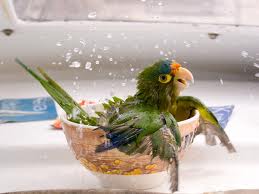Shipping Critters - From Cats To Cobras
James Nelligan, Pacific Pet Transports
 If your last airplane flight had you sitting next to a baboon, it could've been for a client of Pacific Pet Transport. They move animals for the rich and famous. From rhinos to snakes, James Nelligan shares their travels and spills the beans on Alanis Morissette and several other big names.
If your last airplane flight had you sitting next to a baboon, it could've been for a client of Pacific Pet Transport. They move animals for the rich and famous. From rhinos to snakes, James Nelligan shares their travels and spills the beans on Alanis Morissette and several other big names.
James Nelligan started Pacific Pet Transports around 2001. They not only work with commercial airlines, but also with private charters. Their clients include the Hollywood “A” list, to the corporate executive, to the family moving across country. The majority of their business is international, but they also do domestic shipping. James says you can name any type of animal, and they have shipped it!
Everyday is a different day at Pacific Pet Transports, as they never know what type of animal they are going to be asked to move nor do they know the challenges that may come along with it.
James once even moved an entire farm that included horses, goats, pigs and chickens. The rarest animal he has moved was a male Sumatran Rhino from the Los Angeles Zoo back to Indonesia so that he could continue the species, as there are only about 250 left in the world. The most dangerous move was a Monocled Cobra for Jules Sylvester's "Snakes on a Plane" movie. Other animals moved for the film industry include baboons for Rock of Ages and mallard ducks for the Smurfs II movie.
Over all, James states that the most challenging of moves are those requested by rock stars who are touring and want their animals with them in all of the different countries where they are performing. However, every country has different requirements and even quarantines, so not every animal can be shipped to them.
James has done a lot of work for Alanis Morissette, his favorite client. Pacific Pet Transports has moved her Chihuahuas around South American and Europe. When Orland Bloom was doing the Pirates of the Caribbean, they shipped his dogs to the Bahamas.
 Surprisingly, the hardest animals to move are birds. This is because of the bird diseases and the amount of permits that are required. He also mentioned that any bird entering the United States has an automatic 30-day quarantine.
Surprisingly, the hardest animals to move are birds. This is because of the bird diseases and the amount of permits that are required. He also mentioned that any bird entering the United States has an automatic 30-day quarantine.
James states that there's never a dull moment! In all of the years he has been doing this, there was only one escapee when he first started, a cat, and they luckily found him. This was when their airlines weren't as strict on type of crates, and the cat escaped from an open-topped crate, when an employee wanted to check out the cat. Now, James makes sure that all the animals are in secure crates to prevent this from ever happening again.
James got started in the business by shipping surfboards. He happened to be at the airport one day when he saw extremely dehydrated dogs being shipped without water. He knew immediately that he could do a better job. Fortunately, that shipping company is no longer in business.
Visit Website
Lennox Will Not Have Died In Vain!
Tammy Crew, Lennox's Law
 Breed Specific Legislation (BSL) has many up in arms over these ridiculous laws. What's the real story behind Lennox, the dog put to sleep simply because he was a Pit Bull in a county that outlaws them? Even big cities like Denver have said "no" to Pit Bulls. Good laws or just plain arrogance? Tammy Crew tells you about an organization that formed to fight BSL.
Breed Specific Legislation (BSL) has many up in arms over these ridiculous laws. What's the real story behind Lennox, the dog put to sleep simply because he was a Pit Bull in a county that outlaws them? Even big cities like Denver have said "no" to Pit Bulls. Good laws or just plain arrogance? Tammy Crew tells you about an organization that formed to fight BSL.
Lennox was a pug-nosed black dog, who inspired a two-year legal fight and animal-rights protests on both sides of the Atlantic, who was put to sleep amid claims that he was a danger to the public.
Dog wardens seized him from his owners in April 2010. Lennox spent two years in a municipal dog pound while his owners and city authorities battled in the courts. His owner, Caroline Barnes, argued that Lennox was a bull dog mix, not a pit bull terrier, never attacked anyone and could be resettled outside Northern Ireland in a jurisdiction that permits ownership of pit bulls.
Lennox's Law, are a devoted group of animal lovers who's worldwide team is comprised of legal advisors, animal behaviorists, vet techs, management specialists, public speakers, and the list goes on. They all came together through tears, heartbreak and disbelief worldwide over what happened to Lennox.
Their mission is to change the current Breed Specific Legislation globally, to have the deed punished and not the breed. They hope to educate irresponsible owners of bully breeds, as well as educate the public and government officials on the ineffectiveness of this law.
With regard to Lennox, Tammy states that the UK lied and had the wrong dog. She also believes that something happened while Lennox was in custody for two years. The authorities said that Lennox was eventually euthanized, but those at Lennox's Law believe that he actually died before then. Either way, there was a big cover up. Of course the only ones that know for sure what happened are the authorities and the dog himself, but he unfortunately can't talk. Lennox was a young service dog for a special needs child.
Implementing mandatory training programs, spay neuter laws and regulating breeders is far less costly and vastly more effective than BSL. Preventative measures must to be taken if anything is to change. The law as it stands is discriminatory and it costs too many innocent lives to be taken.
Lennox's Law states that Lennox will not have died in vain, and he will NOT be forgotten!
Dogs Get The Flu Too - Canine Influenza - Dr. Debbie
 Can you give your dog the flu, or catch it from him? No way. But dogs can become infected with their own strain of canine influenza. With much attention on the tough human flu season, it's a good time to talk about the differences, and similarities, between human and canine influenza.
Can you give your dog the flu, or catch it from him? No way. But dogs can become infected with their own strain of canine influenza. With much attention on the tough human flu season, it's a good time to talk about the differences, and similarities, between human and canine influenza.
What is Dog Flu?
Canine Influenza, also known as H3N8, was identified in 2004.The disease mutated from a strain of the equine influenza virus and was first detected in racing greyhounds. Canine influenza has migrated across the country, with heavy reports in recent years in New York, New Jersey, Florida and Colorado. However, some areas of the country have yet to report a single case of canine influenza.
Although the human flu peaks in winter seasons, canine influenza doesn't show seasonality; rather dogs can acquire canine influenza all year round.
The Illness
A dog sick with canine influenza develops respiratory infection signs similar to kennel cough that last three to four weeks. Symptoms include coughing, gagging, sneezing, runny nose and high fevers up to 104-106 degrees. Normal dog temperature ranges 101-102 degrees Fahrenheit.
Most dogs infected with canine influenza will get sick and recover. But like the human flu, fatalities can occur. Approximately 5-percent of canine influenza infected dogs may die, usually to secondary pneumonia. Older pets, pups, or those with chronic illness are more likely to develop pneumonia than the average healthy dog.
There isn't a specific treatment for dogs infected with canine influenza, but most dogs recover with supportive care including good nutrition, rest and maintaining adequate hydration. Severely ill pets with secondary bacterial pneumonia may be hospitalized and treated with IV fluids and antibiotics.
Dog Flu Transmission
Dog flu is similar to human flu in that it is spread by aerosol transmission as well as through contact with contaminated items. Since dogs don't cover their cough or sneezes, the virus is easily carried through respiratory droplets to other dogs and items in the immediate area. Any place that canines frequent, or spend time around, can become contaminated by infected dogs - that includes water bowls, surfaces and even human hands.
What do you do if you notice your dog's play pal is coughing, sneezing and has a runny nose? Separate your dog immediately and closely monitor your dog for symptoms for 7 days - the time it takes for symptoms to appear after exposure to the virus. If symptoms develop, call your veterinarian.
 Pass that timeline and you are probably fine. But don't forget that 10 to 20-percent of infected dogs will shed the virus, but never show any symptoms of illness. These apparently healthy carriers can go on and spread the infection to other dogs without ever becoming ill.
Pass that timeline and you are probably fine. But don't forget that 10 to 20-percent of infected dogs will shed the virus, but never show any symptoms of illness. These apparently healthy carriers can go on and spread the infection to other dogs without ever becoming ill.
Vaccination and Prevention Steps
A vaccine is available through veterinarians for canine influenza. But just like the human flu vaccine, it doesn't guarantee your dog CAN'T get sick. However the vaccine is helpful in decreasing the severity of infection and decreasing the spread of virus.
Vaccination for canine influenza isn't recommended for every dog at this time. Lifestyle and geographic location influence an individual dog's risk of acquiring canine influenza. Dogs that frequent high-density dog areas are at increased risk of canine influenza and are candidates for vaccination. So if your dog goes to areas like the dog park, trainer, groomer or boarding facility, ask your veterinarian if vaccination is a good idea.
Don't think you have to keep your dog locked in the house forever to hide from canine influenza. For most dogs, the risk of contracting canine influenza is quite small. Good sense and preventative steps are useful to avoid dog illness. These include quarantining new or sick dogs, using good hygiene through disinfection and hand washing and avoiding unnecessary contact with suspected infected dogs, especially if your dog is young, old, or has a compromised immune system.
What Should Pet Owners Do?
Flu awareness and preparedness makes good sense - for both people and pets. But remember that there are other causes of canine respiratory disease. So just because you hear a cough doesn't mean your dog has the flu. Ask your veterinarian about your pet's individualized risks for acquiring canine influenza.
Featured veterinarian known as "Dr. Debbie" on national pet radio program, Animal Radio. Ebook author of "Yorkshire Terriers: How to Be Your Dog's Best Friend"; "Pugs: How to Be Your Dog's Best Friend"; "Mini Schnauzers: How to Be Your Dog's Best Friend"; and "Shih Tzu: How to Be Your Dog's Best Friend." Dr. Debbie's books.
Visit Website
The Dogfather's Grooming Tip with Joey Villani
Washing Your Smelly Bird
 Joey's latest email includes someone who has written him about their smelly bird. What most people don't know is that birds need baths but need to be wet to clean themselves.
Joey's latest email includes someone who has written him about their smelly bird. What most people don't know is that birds need baths but need to be wet to clean themselves.
There are actually two ways to bathe a bird, one method for a bird that bites and the other for a willing bird. Of course it is always easier if your bird doesn't bite, but about 75-percent of birds will bite you if they don't like what you are doing to them.
For birds that don't bite, you will bathe them in a similar fashion as you would bathe a cat. Get a bucket (about 2 and 1/2 gallons) and fill it with warm water. You want to put enough water in the bucket to where the animal can comfortably stand and have their head sticking out of the water.
Next, add two tablespoons of baking soda. The baking soda will neutralize any odors on the bird. You can then submerge the bird into the water for about 30 seconds. There is no need to rinse, since there hasn't been any soap or other chemicals added to the water. When the bird is removed from the water, they will naturally start to prune themselves.
Be sure when bathing your bird that they are placed in warm room after their bath. The temperature needs to be at least 75 degrees or higher.
If you have a bird that won't let you put it in a bucket, which is probably the majority of birds, get a small spray bottle. If you use a quart-sized bottle, add about a ¼ of a teaspoon of baking soda to warm water. You can then just spray your bird down, even while they are in their cage. They make not like being sprayed, but afterwards they will probably love it, because it will fluff up their feathers, they will start pruning themselves, and they will even take the casings off their feathers.
This is a healthy thing to do to you bird and they won't smell!
Animal Radio News with Stacey Cohen
 Smugglers Used Helicopters To Move Sheep In Hawaii
Smugglers Used Helicopters To Move Sheep In Hawaii
A Maui pilot plead guilty to loading deer on helicopters and flying them from Maui and the Big Island, offering a glimpse into an alleged scheme by hunters to move deer and sheep between the Hawaiian Islands to establish new game populations for their sport. Neither axis deer nor mouflon sheep, the specific animals that were involved, are native to Hawaii and don’t have natural predators here. Their presence damaged fragile native ecosystems and farms on the islands where they had become established. The alleged animal smugglers took axis deer from Maui to the Big Island and dropped them off to roam. Officials said they took Big Island sheep to a Maui hunting ranch, but apparently didn’t release them to the wild. Axis deer are native to India. They don’t have natural predators in Hawaii, so the population exploded on islands where they had become established. A Maui County survey estimated the animals caused $1 million in damage for farmers, ranchers and resorts in two years.
Pet Food Served To Prisoners
An east Texas meat manufacturing company paid the U.S. Treasury about $400,000 for mislabeling pet food that was eaten by prisoners. John Soules Foods had problems with some "beef trimmings," so the manufacturer sold them to a meat broker without changing the label to pet food. That raw meat was sold to the Federal Bureau of Prisons. No prisoners got sick eating the beef, but it kicked off a three-year investigation. Due to the settlement, the company didn’t face criminal charges.
 Baby Boomers Giving Up On Pets
Baby Boomers Giving Up On Pets
While we have heard about people abandoning animals because they couldn’t afford them any longer, it’s more likely the decline in ownership is due to people choosing not to bring new pets into their households after their old pets have passed away and the aging baby boomer population may be part of the reason. When the kids leave home, people tend not to have pets. Foreclosures have also played a big role in the decrease in pet ownership. Paying veterinary bills are also a large part of the burden of owning a pet, while the cost of vet care is on the rise.
Slaughterhouse Closed Due To Mistreatment
The USDA closed down a central California slaughterhouse. The move was made due to a video, which showed cows being mistreated during the slaughtering process. The group Compassion Over Killing posted video of the facility on the Internet. The video showed cows flailing in a wild fashion as they were dragged by one leg on a conveyer belt en route to being slaughtered. The farm is based 30 miles south of Fresno.
 Listen to the entire Podcast of this show (#1190)
Listen to the entire Podcast of this show (#1190)





